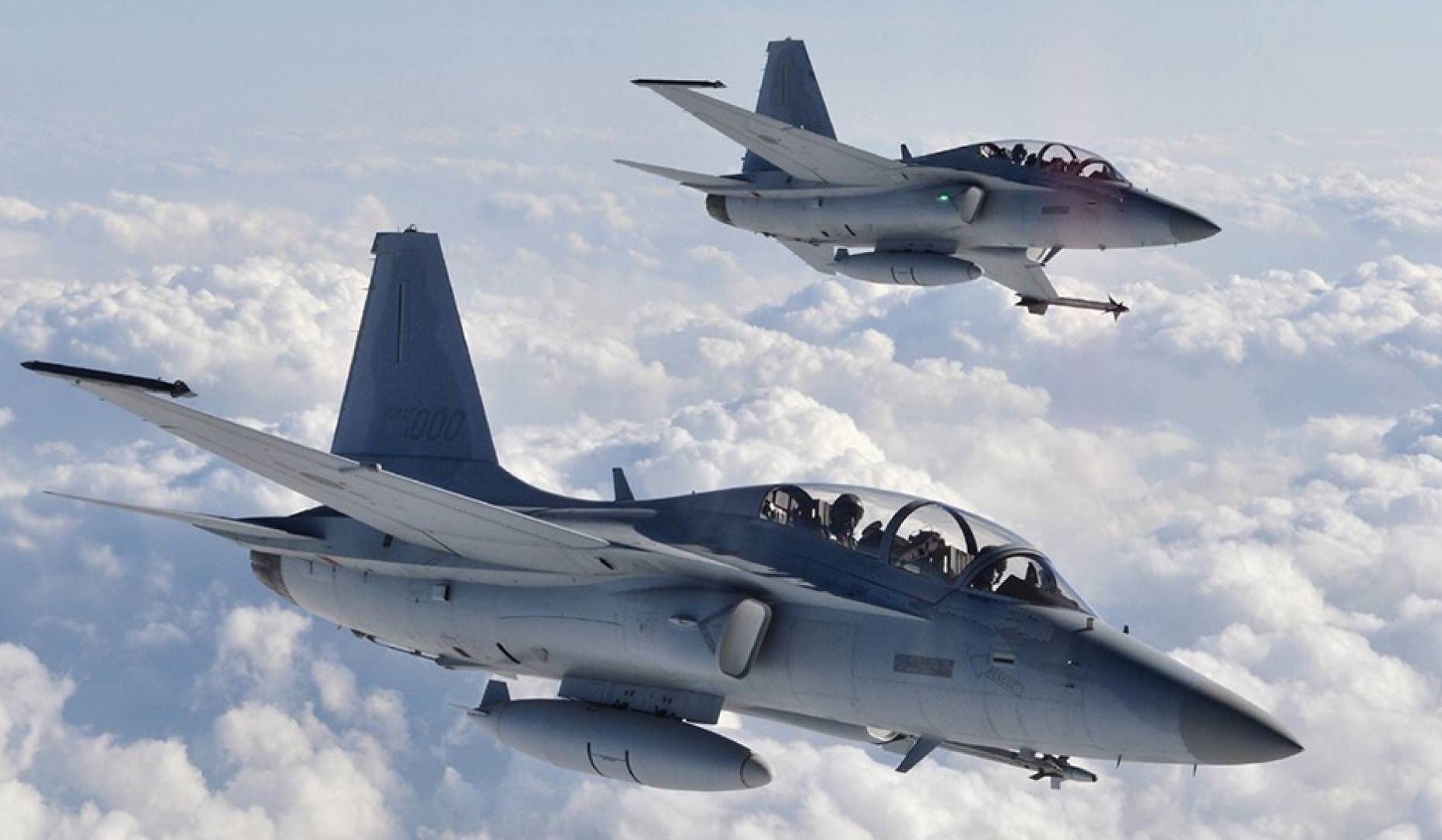The FA-50GF fighter jets in service with the Polish Air Force will finally have new munitions: the AIM-9L Sidewinder missiles.
The Polish Deputy Prime Minister, Władysław Kosiniak-Kamysz, and Secretary of State, Paweł Bejda, finalized the contracts for the acquisition of 24 AIM-9L Sidewinder missiles to equip the Polish FA-50GF aircraft.
The decision was taken on June 30 and also included contracts for the delivery of twelve Medical Evacuation Vehicles based on the KTO ROSOMAK chassis.
The Polish Ministry of National Defense signed two contracts to purchase 48 FA-50 light attack aircraft from South Korea in 2022, comprising the interim FA-50GF (Gap Filler) aircraft and 36 FA-50PL aircraft, which will be tailored to meet the requirements of the Polish Air Force.
While the Eastern European country has received all 12 FA-50GF, they have remained unarmed so far, becoming a point of contention within the country. Thus, making the latest contract for AIM-9L more noteworthy.
“The FA-50 aircraft is finally armed, it is finally ready not only for training, but also for combat operations,” the Defence Minister Wladyslaw Kosiniak-Kamysz declared emphatically at the contract signing ceremony.
Notably, the FA-50GF is currently only capable of using the legacy variants of the iconic Sidewinder, including the AIM-9L and M.
The FA-50GF’s lack of integrated armament, and particularly its inability to use modern AIM-9X missiles, had come under scrutiny in Warsaw. Earlier, the Deputy Minister of Defence Cezary Tomczyk criticised the purchase of the aircraft, saying: The FA-50s are ‘probably the world’s first training-combat aircraft that are not combat-capable… We have a training-combat aircraft that is for training but not for combat.”
However, commentators reasoned against the criticism, arguing that the FA-50GF is merely a transitional aircraft that will eventually be upgraded to the PL variant. They argued that the GF variant was only for training and would eventually be supplemented by the FA-50PL equipped with the AIM-9X Sidewinder, a weapon already present in Poland.
#Warszawa | W obecności wicepremiera W. @KosiniakKamysz oraz sekretarza stanu w MON @pawelbejda, podpisano umowy na dostawę pocisków rakietowych AIM-9L dla lekkich samolotów bojowych FA-50 oraz na dostawę dwunastu Wozów Ewakuacji Medycznej na podwoziu KTO ROSOMAK. pic.twitter.com/kag4ZR2Mh0
— Ministerstwo Obrony Narodowej 🇵🇱 (@MON_GOV_PL) June 30, 2025
For now, the integration of the AIM-9L, which has basic air-to-air defense capability, on the FA-50GF will enable Poland to maintain its operational capability for NATO air policing and air defense missions in the near term.
The AIM-9L’s infrared seeker can lock onto targets from any angle, including head-on engagements, due to its more sensitive, cooled seeker head, which should make it suitable for air policing.
The missile features an advanced guidance system with better resistance to countermeasures, such as flares, due to its ability to distinguish between a target’s heat signature and decoys.

Additionally, the AIM-9L is equipped with a 9.4 kilograms annular blast-fragmentation warhead, paired with a laser proximity fuze for improved lethality. This allows the missile to detonate at an optimal distance from the target, thereby increasing the likelihood of a successful kill.
During the 1982 Falklands War, both American and British forces extensively used the AIM-9L, achieving impressive success rates. The AIM-9L was widely exported to US allies and integrated into the air forces of various countries globally.
With its reliability and versatility, it was a cornerstone of air-to-air combat during that era. The AIM-9L has been succeeded by newer variants, such as the AIM-9M and AIM-9X, which offer further advancements in countermeasures resistance, off-boresight targeting, and overall performance.
Polish FA-50 Light Attack Aircraft
Poland purchased the FA-50 in 2022, along with other South Korean systems such as K9 self-propelled artillery systems, K2 Black Panther tanks, and Chunmoo multiple rocket launch systems, as part of a massive military modernization effort launched in the wake of Russia’s invasion of Ukraine.
Produced by Korean Aerospace Industries (KAI), the FA-50 is based on the T-50, a trainer aircraft capable of supersonic flight that was modified from the F-16 to train pilots for the KF-16 and F-15K.
Poland chose the FA-50 over the American F-16 and received the first two aircraft just ten months after inking the deal with KAI. Some reports suggested that it opted for the FA-50 because it would arrive sooner than the cutting-edge F-16 Vipers.
The FA-50 is predominantly designed for air defense, strike, and jet training missions. According to information on KAI’s website, the FA-50 features a long radome, a tactical datalink, enhanced avionics, a larger internal fuel capacity, precision-guided munitions, and self-protection subsystems, among other things.
KAI delivered the 12 FA-50GF in record time, as these were provisional jets that were pulled out of its own stockpile. It was initially anticipated to provide 36 units of the upgraded FA-50PL variant starting from the second half of 2025 through 2028. However, these deliveries are now delayed
The FA-50PL is intended to replace Poland’s aging Su-22 and MiG-29 fleets, enhance air defense capabilities, and support pilot training for F-16 and F-35 aircraft, leveraging its compatibility with F-16 avionics. According to reports, these delays are caused by the complexity and cost of integrating new systems.
Poland has reportedly requested the integration of systems such as Raytheon’s PhantomStrike radar, in-flight refueling capability, helmets with integrated HMD displays, GBU laser-guided bombs, and compatibility with AIM-120 AMRAAM and AIM-9X Sidewinder missiles for the 36 FA-50PL.
Due to the intricacy of these modifications, the development period has been prolonged, and reports last year suggested that the aircraft will not be fully operational until after 2028, as originally scheduled.

Although more than five FA-50PL aircraft are believed to be in various stages of production at KAI’s Sacheon facility, the complexity of modifying the aircraft to Polish specifications has slowed the production line. Polish authorities, Lockheed Martin, which is a major avionics and systems partner, and KAI are collaborating on the integration process, which has made it more complex.
Additionally, obtaining bureaucratic approvals from the US for the integration of American weapons such as AMRAAM has led to delays.
According to some reports, an FA-50PL prototype is expected to make its maiden flight in November 2025, pending final specification approval. This will be followed by a minimum nine-month implementation period afterward, which will further delay production. Reports indicate deliveries may slip to mid-2027 at the earliest, with full operational capability (FOC) potentially pushed beyond 2028.
The delays hinder Poland’s ability to fully retire its aging Soviet-era fighter jet fleets, maintaining reliance on aging aircraft that are less interoperable with NATO systems. Nonetheless, the integration of AIM-9L Sidewinder on the FA-50GF should alleviate the situation by making the GF variants combat-capable.
- Contact the author at sakshi.tiwari9555 (at) gmail.com
- Follow EurAsian Times on Google News




